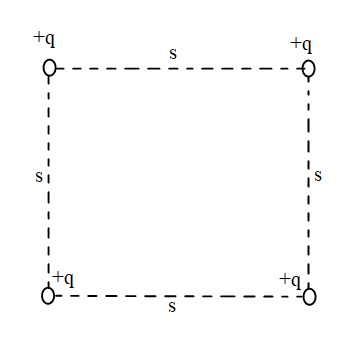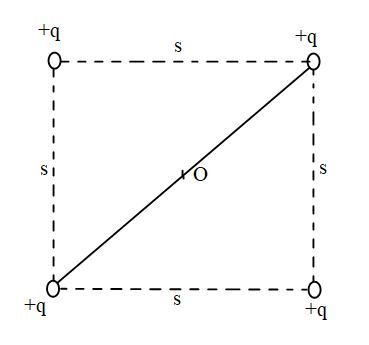
Calculate the electric potential at the center of the square:

A) 0.
B) $k\dfrac{{2q}}{{{s^2}}}$.
C) $k\dfrac{{4q}}{{{s^2}}}$.
D) $k\dfrac{{4q}}{s}$
E) $k\dfrac{{4\sqrt 2 q}}{s}$
Answer
219.9k+ views
Hint: The formula of the potential difference can be used to calculate the correct answer for this problem. The potential difference at any point depends upon the magnitude of the charge and the distance from the charged particle.
Formula Used:
The formula of the potential difference which depends upon the distance from the charge and a charged particle is given by ${\text{V}} = k\dfrac{q}{x}$. Where k is constant V is the potential difference q is the charge also x is the distance between the charge and the point where the potential difference is to be calculated.
Complete step by step answer:
As it is given that all the charged particles are at the four corners of the square so we need to calculate the distance of centre from each particle and as it’s a symmetrical shape therefore the distance from one charged particle to centre will be equal for all the cases.
Let us calculate the length of the diagonal and then we can half it to get the required distance.

Applying Pythagoras theorem.
$ \Rightarrow {\left( {2x} \right)^2} = {s^2} + {s^2}$
$ \Rightarrow 4{x^2} = 2{s^2}$
$ \Rightarrow 2{x^2} = {s^2}$
$ \Rightarrow x = \dfrac{s}{{\sqrt 2 }}$
As we know that potential difference at any point which is x distance from the charge particle with charge q and k as constant is given by${\text{V}} = k\dfrac{q}{x}$.
Potential difference due to charge particle 1 is ${{\text{V}}_{\text{1}}} = k\dfrac{q}{x}$ where $x = \dfrac{s}{{\sqrt 2 }}$ therefore.
$ \Rightarrow {{\text{V}}_{\text{1}}} = k\dfrac{{\sqrt 2 \cdot q}}{s}$
The potential difference for the rest of the particles is given by${{\text{V}}_2} = k\dfrac{{\sqrt 2 \cdot q}}{s}$,${{\text{V}}_3} = k\dfrac{{\sqrt 2 \cdot q}}{s}$and${{\text{V}}_4} = k\dfrac{{\sqrt 2 \cdot q}}{s}$.
As all the conditions for the 4 charged particles are the same therefore total potential difference is equal to ${{\text{V}}_{{\text{total}}}}$.
$ \Rightarrow {{\text{V}}_{{\text{total}}}} = k\dfrac{{\sqrt 2 \cdot q}}{s} + k\dfrac{{\sqrt 2 \cdot q}}{s} + k\dfrac{{\sqrt 2 \cdot q}}{s} + k\dfrac{{\sqrt 2 \cdot q}}{s}$
$ \Rightarrow {{\text{V}}_{{\text{total}}}} = 4k\dfrac{{\sqrt 2 \cdot q}}{s}$.
So the correct answer for this problem is option D
Note: It is advisable for students to remember and understand the concept of the potential difference at any point with some distance having some charge as it can help in solving these types of problems. Also it should be observed that the potential difference due to all the charges is exactly equal because the magnitude and sign of the charge was also the same. Also note that electric potential is a scalar quantity.
Formula Used:
The formula of the potential difference which depends upon the distance from the charge and a charged particle is given by ${\text{V}} = k\dfrac{q}{x}$. Where k is constant V is the potential difference q is the charge also x is the distance between the charge and the point where the potential difference is to be calculated.
Complete step by step answer:
As it is given that all the charged particles are at the four corners of the square so we need to calculate the distance of centre from each particle and as it’s a symmetrical shape therefore the distance from one charged particle to centre will be equal for all the cases.
Let us calculate the length of the diagonal and then we can half it to get the required distance.

Applying Pythagoras theorem.
$ \Rightarrow {\left( {2x} \right)^2} = {s^2} + {s^2}$
$ \Rightarrow 4{x^2} = 2{s^2}$
$ \Rightarrow 2{x^2} = {s^2}$
$ \Rightarrow x = \dfrac{s}{{\sqrt 2 }}$
As we know that potential difference at any point which is x distance from the charge particle with charge q and k as constant is given by${\text{V}} = k\dfrac{q}{x}$.
Potential difference due to charge particle 1 is ${{\text{V}}_{\text{1}}} = k\dfrac{q}{x}$ where $x = \dfrac{s}{{\sqrt 2 }}$ therefore.
$ \Rightarrow {{\text{V}}_{\text{1}}} = k\dfrac{{\sqrt 2 \cdot q}}{s}$
The potential difference for the rest of the particles is given by${{\text{V}}_2} = k\dfrac{{\sqrt 2 \cdot q}}{s}$,${{\text{V}}_3} = k\dfrac{{\sqrt 2 \cdot q}}{s}$and${{\text{V}}_4} = k\dfrac{{\sqrt 2 \cdot q}}{s}$.
As all the conditions for the 4 charged particles are the same therefore total potential difference is equal to ${{\text{V}}_{{\text{total}}}}$.
$ \Rightarrow {{\text{V}}_{{\text{total}}}} = k\dfrac{{\sqrt 2 \cdot q}}{s} + k\dfrac{{\sqrt 2 \cdot q}}{s} + k\dfrac{{\sqrt 2 \cdot q}}{s} + k\dfrac{{\sqrt 2 \cdot q}}{s}$
$ \Rightarrow {{\text{V}}_{{\text{total}}}} = 4k\dfrac{{\sqrt 2 \cdot q}}{s}$.
So the correct answer for this problem is option D
Note: It is advisable for students to remember and understand the concept of the potential difference at any point with some distance having some charge as it can help in solving these types of problems. Also it should be observed that the potential difference due to all the charges is exactly equal because the magnitude and sign of the charge was also the same. Also note that electric potential is a scalar quantity.
Recently Updated Pages
Electricity and Magnetism Explained: Key Concepts & Applications

JEE Energetics Important Concepts and Tips for Exam Preparation

JEE Isolation, Preparation and Properties of Non-metals Important Concepts and Tips for Exam Preparation

JEE Main 2021 July 25 Shift 1 Question Paper with Answer Key

JEE Main 2021 July 22 Shift 2 Question Paper with Answer Key

States of Matter Chapter For JEE Main Chemistry

Trending doubts
JEE Main 2026: Application Form Open, Exam Dates, Syllabus, Eligibility & Question Papers

Understanding Uniform Acceleration in Physics

Derivation of Equation of Trajectory Explained for Students

Hybridisation in Chemistry – Concept, Types & Applications

Understanding the Angle of Deviation in a Prism

Understanding Atomic Structure for Beginners

Other Pages
JEE Advanced Marks vs Ranks 2025: Understanding Category-wise Qualifying Marks and Previous Year Cut-offs

Dual Nature of Radiation and Matter Class 12 Physics Chapter 11 CBSE Notes - 2025-26

How to Convert a Galvanometer into an Ammeter or Voltmeter

Understanding Centrifugal Force in Physics

JEE Main Marking Scheme 2026- Paper-Wise Marks Distribution and Negative Marking Details

Degree of Dissociation: Meaning, Formula, Calculation & Uses




